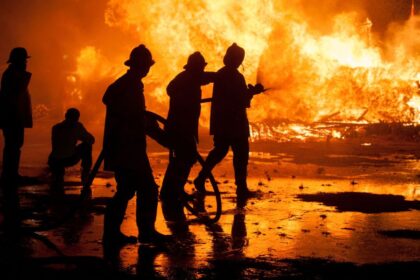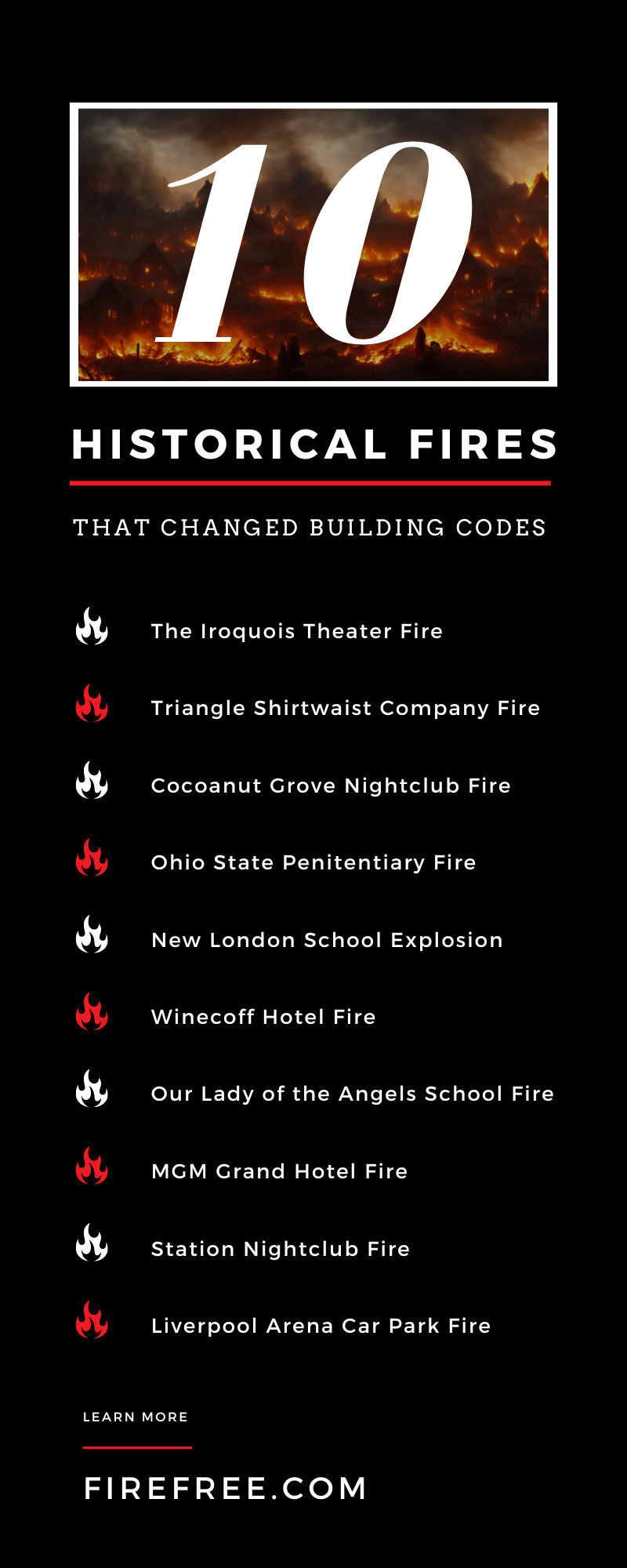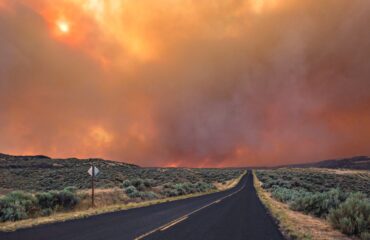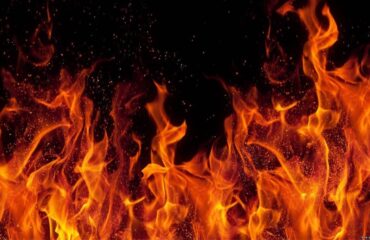
Some historical events can forever change the way we live and work. Prime examples of these events are previous fire emergencies that have influenced current fire safety codes and standards. Here are some examples of historical fires and how they changed building codes and safety regulations forever.
The Iroquois Theater Fire
The Iroquois Theatre fire took place in Chicago, Illinois, in 1903. This fire remains one of the deadliest single-building fires in US history. Despite being considered “absolutely fireproof” at the time, several unfortunate circumstances and factors contributed to the historic fire that broke out and killed 602 people. A lack of fire codes and enforcement of fire safety at the time led to blocked exits, no sprinkler systems or fire alarms, and ineffective extinguishers.
The Iroquois Theatre fire is one of the most relevant historical fires to our modern building codes. The gravity of this event caused lawmakers at the time to rethink the need for building codes to minimize risks and loss of life in the future. This emergency event encouraged restrictions on maximum seating and standing capacity, improved fire exits and routes, and well-marked exit signage.
Triangle Shirtwaist Company Fire
The Triangle Shirtwaist Company was a factory that operated on the top three floors of a 10-story building. A combination of factors led to the devastating fire on March 25, 1911, including a lack of fire safety training, insufficient stairs and fire exits, poorly designed doors, and combustible materials.
After the Triangle Shirtwaist Company fire, several new considerations to fire safety codes came to be. These included mandatory fire drills, the inclusion of sprinkler systems, and more guidelines for designing fire escapes.
Cocoanut Grove Nightclub Fire
The Cocoanut Grove Nightclub fire took place in Boston, Massachusetts, in 1942. This fire is still known as the deadliest nightclub fire in the US. The nightclub was reportedly filled to twice its maximum 460-person capacity at the time of the fire, which is what led to 492 casualties. Like with the Iroquois Theater fire, this venue also had poorly marked exits, and the ones that were available were sealed shut, making escape difficult.
The Cocoanut Grove Nightclub fire promoted further advancements with exit doors, including collapsible panels on revolving doors and well-marked exits. It also enforced more restrictions on the combustibility and flammability of interior finishes and furnishings.
Ohio State Penitentiary Fire
The Ohio State Penitentiary was another structure that managers at the time claimed to be fireproof. However, on April 21, 1930, a fire broke out and spread from materials from a recent renovation. The prisoners had already been locked in their cells for the night, which caused many casualties and injuries as the fire spread, leaving 320 inmates dead.
The Ohio State Penitentiary fire forever changed the way we design and enforce fire codes for prisons. The National Fire Protection Association now enforces building codes that require correctional facilities to feature noncombustible materials and have automatic sprinklers and detection systems installed.
New London School Explosion
The New London School explosion occurred in 1937 in New London, Texas. This fire is still known as the worst school disaster in US history. The explosion originated from an undetected natural gas leak in the building’s crawl space. Because natural gas is odorless, it spread through the school until contacting an electrical source, which ignited the gas and caused the explosion. Almost 300 students and teachers lost their lives in the event.
While not strictly a fire event, the New London School explosion also changed fire safety forever. After the disaster, the Texas government began requiring manufacturers to add mercaptans to natural gas to give it an odor. This is now a safety practice worldwide.
Winecoff Hotel Fire
The Winecoff Hotel fire took place in Atlanta, Georgia, in 1946. With 119 deaths, it is known as one of the deadliest hotel fires in US history. The fire quickly spread to the upper floors of the building and trapped those inside due to the building only having one exit stairway. Propped-open doors and no fire sprinklers led to the flames spreading quickly throughout the hotel.
The Winecoff Hotel fire showed the need for hotel fire safety codes. This event further illustrated the need for sprinklers in all types of establishments. It also showed the importance of having several clearly marked exit stairwells and fire doors that separate the flames.
Our Lady of the Angels School Fire
Another historic fire that forever changed school settings was the fire at Our Lady of Angels School. This fire occurred in 1958 at a private school in Chicago, Illinois. The fire began in a trashcan in the basement and spread throughout the school and into the attic, blocking many of the escape routes. Its large spread was due to a high quantity of combustible materials and few safety measures.
The Our Lady of Angels school fire illustrated that all schools needed to have the same requirements for fire protection. It led to the addition of fire alarms, sprinkler systems, fire doors, and emergency lighting in school buildings. This event also stressed the importance of fire exit and escape route design, including doors that open outward, exit stairwells, and noncombustible materials.
MGM Grand Hotel Fire
The MGM fire occurred in Las Vegas, Nevada, in 1980. This hotel and casino had a maximum capacity of over 5,000 guests but still no sprinkler system. When a fire broke out, there were minimal ways of combating the flame and smoke spread. Many of the guests on the upper floors were exposed to toxic fumes and smoke due to the poor ventilation system.
This fire changed building codes in hotels and casinos forever, as it clearly outlined the need for sprinkler systems in large buildings. It also challenged policymakers to find ways to limit smoke travel and movement during a fire.
Station Nightclub Fire
One of the more recent emergency events to change the way we think of building codes was the Station Nightclub Fire in 2003. The fire occurred after a stage manager set off pyrotechnics during the headliner’s show, which spread to the soundproofing foam backstage. While the club was not overcrowded, there was no sprinkler system, and the chaos caused a jam at the entrance when guests tried to exit en masse.
The Station Nightclub fire illustrated that even in more modern buildings, sprinkler systems are still crucial for containing fires. This event also shows how important Class A fire retardant paint and coatings can be for covering materials such as insulation and soundproofing.
Liverpool Arena Car Park Fire
Another example of a recent influential fire was the Liverpool Arena Car Park fire. This fire broke out in a parking facility during an equestrian event. Fortunately, there were no fatalities, but the fire damaged 1,400 cars during the event.
This fire emergency stressed the importance of sprinkler systems for all types of structures, even parking garages. While there were no casualties, it also reminds us of the importance of safe and efficient evacuation.
These 10 historical fires that changed building codes are essential to keep in mind as we move forward with fire safety laws and requirements. We can learn from these previous building design mistakes to create structures that are safer and better equipped to withstand fires and other emergency events. If you are looking for ways to increase your building’s protection against fire, check out our selection of fire-resistant paints at Firefree Inc. today.


